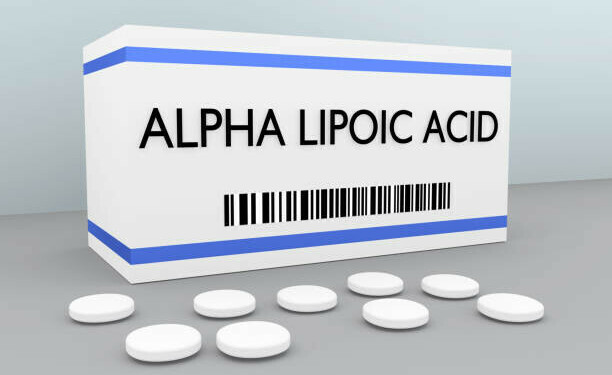Today, I’d like to draw your kind attention to a natural acid that is extremely beneficial to eyesight natural improvement among other benefits and discuss about “Alpha Lipoic Acid Uses”. Alpha Lipoic Acid (ALA) is a compound that naturally occurs in every cell of the human body. It plays a vital role in antioxidation and energy production. Its unique ability to function in water and fat sets ALA apart, making it a versatile and effective antioxidant. This dual solubility allows ALA to reach all parts of the cell, providing powerful protection against oxidative stress. In addition to its role within the cells, ALA helps regenerate other antioxidants, such as vitamins C and E, further strengthening the body’s defense against free radicals.
Alpha lipoic acid (ALA) has been used in healthcare for many years. It gained attention in the mid-20th century as a coenzyme in mitochondrial bioenergetic processes. Over time, its medical uses have expanded, with research showing its potential in managing conditions like diabetic neuropathy, liver diseases, and certain cardiovascular ailments. The discovery of its multifaceted benefits has elevated ALA from an obscure nutrient to a key element in modern integrative medicine.
The benefits of Alpha Lipoic Acid are extensive and diverse, reaching beyond its antioxidant properties. According to research, it shows promise in improving insulin sensitivity, which could benefit people with diabetes. Additionally, its anti-inflammatory characteristics play a role in decreasing symptoms of chronic illnesses, contributing to its effectiveness. Additionally, ALA has been researched for its possible neuroprotective effects, which could be relevant for neurodegenerative diseases like Alzheimer’s. The wide range of benefits ALA offers highlights its significance as a dietary supplement and therapeutic agent.

This article examines the different applications and advantages of alpha lipoic acid (ALA), specifically promoting eye health. Our eyesight is valuable and can be affected by conditions such as glaucoma, cataracts, and macular degeneration. Recent studies have proposed that ALA’s potent antioxidant properties are critical in safeguarding and improving eye health. ALA may help preserve eyesight and prevent age-related eye conditions by reducing oxidative stress and inflammation.
Join us as we delve into the science behind Alpha Lipoic Acid, its historical and current uses, and how this remarkable antioxidant can be a cornerstone of your health routine, especially for maintaining optimal eye health. From understanding its biochemical mechanisms to practical tips on incorporating it into your diet, this comprehensive guide will provide you with the knowledge to utilize the power of Alpha Lipoic Acid for a healthier future.
A Visionary Solution: Alpha Lipoic Acid’s Role in Eye Health
Alpha Lipoic Acid (ALA) is now recognized as a promising solution for promoting and maintaining optimal eye health. As we navigate an increasingly digital world, our eyes are subjected to more strain and potential damage than ever. Therefore, the role of antioxidants in preserving ocular health is vital. Antioxidants such as ALA are crucial for safeguarding the eyes against oxidative stress, a significant contributor to the deterioration of eye tissues, and the development of various eye diseases.

Alpha Lipoic Acid is notable among antioxidants due to its exceptional ability to function in water and fat environments. This distinctive characteristic enables it to permeate and safeguard all parts of the eye, from the aqueous humor to the lipid-rich retinal tissues. By counteracting free radicals, ALA assists in maintaining the structural integrity and functionality of the eye’s delicate components. This potent antioxidant also aids in replenishing other antioxidants within the body, enhancing overall ocular defense mechanisms.
Studies have highlighted numerous ways alpha lipoic acid can enhance eyesight and protect against eye diseases. One of its most significant advantages is its potential to address glaucoma. Elevated intraocular pressure in glaucoma can lead to damage to the optic nerve. ALA has been proven to lower intraocular pressure and enhance visual function in individuals with glaucoma. Additionally, its anti-inflammatory properties can relieve symptoms of dry eye syndrome and protect against age-related macular degeneration (AMD), a significant cause of vision loss in older adults.
Scientific research has presented compelling evidence supporting the effectiveness of alpha lipoic acid (ALA) for eye health. In a noteworthy study, individuals with open-angle glaucoma who received ALA supplementation experienced substantial enhancements in visual field parameters. Another study showcased ALA’s ability to mitigate oxidative damage in retinal cells, indicating its potential to prevent or slow AMD progression. These findings emphasize the significance of integrating ALA into one’s health regimen for sustained ocular health.

In addition to scientific research, user endorsements and personal experiences further affirm the benefits of Alpha Lipoic Acid for eye health. Many individuals have reported noticeable improvements in their vision and relief from eye strain after integrating ALA supplements into their daily routine. For instance, a 45-year-old graphic designer, Sarah, shared how ALA helped alleviate her computer-induced eye fatigue and improved her overall visual clarity. John, a retiree coping with early-stage glaucoma, commended ALA for preserving his visual field and quality of life.
As we continue to explore the potential of alpha lipoic acid (ALA), it becomes increasingly evident that this versatile antioxidant presents a promising approach for preserving and enhancing eye health. Whether through scientific substantiation or personal endorsements, the advantages of ALA are significant, making it an essential component of any strategy for maintaining eye health. Incorporating ALA into your daily regimen could be integral to sustaining sharp, healthy vision in the years ahead.
Beyond the Eyes: Systemic Benefits of Alpha Lipoic Acid Supplementation

Alpha Lipoic Acid (ALA) plays a crucial role in maintaining eye health and has far-reaching effects on our overall well-being. Its impact extends to various aspects of our health beyond just the eyes. ALA’s critical function in metabolic processes and energy production is noteworthy. It is an essential cofactor for mitochondrial enzymes that convert nutrients into energy. By improving mitochondrial function, ALA supports optimal energy levels vital for physical and mental performance.
When it comes to managing diabetes, Alpha Lipoic Acid has shown significant potential. The capacity to improve insulin sensitivity makes it a valuable asset for people with type 2 diabetes. ALA facilitates better glucose uptake by cells, helping regulate blood sugar levels more effectively. Additionally, its antioxidant properties can reduce oxidative stress and inflammation, critical factors in diabetic complications. Research has suggested that using ALA as a supplement can relieve symptoms of diabetic neuropathy, including pain, burning, and numbness, leading to an enhanced quality of life for numerous patients.

Another area of considerable interest is Alpha Lipoic Acid’s neuroprotective properties. The high consumption of oxygen and the presence of lipids make the brain highly vulnerable to oxidative damage. ALA is capable of crossing the blood-brain barrier, providing robust protection against neurodegenerative diseases such as Alzheimer’s and Parkinson’s. ALA supports cognitive function and mental clarity by neutralizing free radicals and reducing inflammation. Additionally, new studies indicate that ALA might assist in easing symptoms of anxiety and depression, providing a natural way to enhance mental well-being.
Alpha Lipoic Acid also shows promise in skin care applications. Its antioxidant power shields the skin from the harmful effects of UV radiation and environmental pollutants. ALA can also boost collagen production, helping to minimize the look of fine lines and wrinkles for a more youthful and radiant skin. Additionally, its anti-inflammatory characteristics can alleviate irritated skin, which is advantageous for conditions like acne and rosacea. Regular supplementation of ALA can contribute to a radiant and healthy complexion, serving as a natural defense against the signs of aging.

In conclusion, alpha lipoic acid is a multidimensional compound with a wide range of systemic benefits. Its potential spans from enhancing energy production and metabolic functions to managing diabetes and protecting the brain. Additionally, its use in skincare emphasizes its adaptability, positioning it as a beneficial inclusion in anyone’s health routine. Embracing ALA supplementation could improve health and vitality, helping you look and feel your best at every stage of life.
Incorporating Alpha Lipoic Acid into Your Daily Regimen

Incorporating alpha lipoic acid (ALA) into your daily schedule can be crucial in attaining peak health. This potent antioxidant comes in various forms, such as pills, tablets, and even intravenous solutions, making it convenient to adjust your intake to fit your preferences and lifestyle. It is suggested that individuals begin with a daily intake of 300 to 600 mg to enjoy the advantages ALA provides.
However, dosages may vary depending on individual health needs and goals, so it’s essential to begin with a lower dose and gradually increase it as your body becomes accustomed to it.
One exciting aspect of Alpha Lipoic Acid is its ability to work in harmony with other nutrients, enhancing their effectiveness. For example, ALA can renew antioxidants like Vitamin C and E, boosting their protective abilities. Combining ALA with Coenzyme Q10 (CoQ10) can further enhance energy production and antioxidant defense, as both substances play vital roles in mitochondrial function. Furthermore, pairing ALA with acetyl-L-carnitine can help support cognitive health and combat oxidative stress more effectively. To maximize these benefits, consider taking ALA with meals containing healthy fats, which can improve its absorption.
When adding Alpha Lipoic Acid to your daily regimen, it’s important to consider dietary adjustments and lifestyle changes that support its effects. Make sure your body gets a variety of antioxidants and essential nutrients by concentrating on a well-rounded diet that incorporates plenty of fruits, vegetables, whole grains, and lean proteins. Decreasing the consumption of processed foods and sugars can also aid in managing oxidative stress and inflammation. Regular physical activity is another crucial element, as exercising boosts your body’s inherent antioxidant defenses and enhances overall health.

Before starting any supplementation regimen, including Alpha Lipoic Acid, seeking guidance from healthcare professionals is essential. Individualized guidance can be provided based on your health condition, medical background, and particular requirements. This is especially crucial for people with existing health issues or those using other medications, as ALA may have interactions with specific drugs and medical therapies. A healthcare provider can assist you in identifying the appropriate quantity and variety of ALA and keep track of your development to ensure optimal results.
In conclusion, incorporating Alpha Lipoic Acid into your daily routine can yield numerous health benefits, from increased energy production to improved antioxidant defense. By understanding the recommended dosages, utilizing synergistic nutrient combinations, and making supportive dietary and lifestyle changes, you can maximize the positive impact of ALA on your health. Always seek professional medical advice to customize your supplementation strategy to your unique needs, ensuring a safe and effective path toward better health.
Precautions and Potential Side Effects of Alpha Lipoic Acid
When considering adding alpha lipoic acid (ALA) to your health routine, it’s essential to understand the potential side effects and necessary precautions which are still very minor ones that can be very much tolerated. While ALA is generally well-tolerated, some individuals may experience mild and minor side effects compared to its great benefits. Common side effects consist of gastrointestinal issues like nausea, vomiting, and diarrhea. On occasion, people may observe a rash or itching, especially when starting with higher doses. Commencing with a lower dose and gradually increasing it as your body adapts is recommended to reduce these effects.

Many myths exist regarding the safety of Alpha Lipoic Acid, which can cause unnecessary worry. However, clinical evidence consistently backs the safety of ALA when used appropriately. One common myth is that prolonged use of ALA can result in severe health problems. In contrast to this belief, studies have shown that ALA, even at higher doses, does not present significant risks for most people. Relying on scientific research and clinical trials is crucial as they show that ALA is a safe and effective supplement when taken responsibly.
Before starting ALA supplementation, interactions with medications or pre-existing conditions are essential. ALA can interact with certain medications, particularly those used to manage diabetes. ALA’s enhancement of insulin sensitivity could decrease blood sugar levels, raising the risk of hypoglycemia when combined with antidiabetic medications. It’s also crucial for individuals with thyroid conditions to be cautious, as ALA might affect thyroid hormone levels. If you are on any medication or have a chronic condition, consult your healthcare provider before integrating ALA into your routine to avoid adverse interactions.

Responsible use of supplements, including Alpha Lipoic Acid, demands a well-informed approach. Always follow the recommended dosages and resist exceeding them, thinking that more is better. Commencing with smaller amounts and incrementally raising them as needed allows your body to adjust and reduces the chances of experiencing side effects. Consistent discussions with a healthcare provider can guarantee that the supplement functions efficiently and securely as part of your comprehensive health strategy.
The benefits of alpha lipoic acid (ALA) are plentiful, but it’s important to be aware of its potential side effects and interactions to ensure safe and efficient usage. You can confidently include ALA in your health routine by dispelling myths with clinical evidence, understanding common side effects, and consulting healthcare providers. Responsible supplementation, coupled with professional guidance, will help you maximize the benefits of ALA while minimizing any risks, ensuring a positive impact on your health and well-being.
Thank you for reading my article about how “Alpha Lipoic Acid Uses”, and I would love to receive your comments down below, in case of any.

